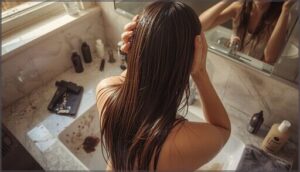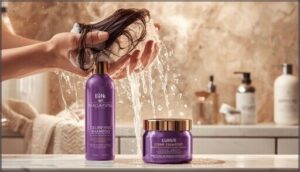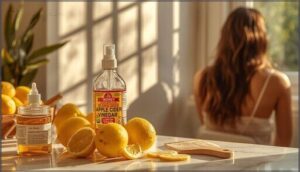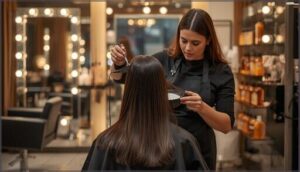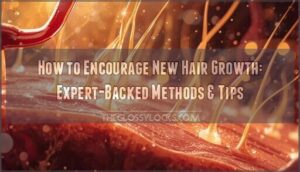This site is supported by our readers. We may earn a commission, at no cost to you, if you purchase through links.
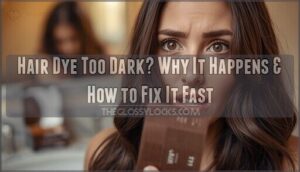
You followed the instructions, mixed your dye carefully, and waited the recommended time. But when you rinsed and looked in the mirror, your hair was several shades darker than the box promised. This frustrating scenario happens more often than you’d think, and it’s rarely your fault.
Hair dye can darken due to porosity issues, overlapping applications, or even the lingering effects of previous color treatments your hair remembers long after you’ve forgotten them.
The good news is that overly dark hair isn’t permanent, and you have options ranging from simple home remedies to professional color correction. Understanding why your hair grabbed too much pigment is the first step toward getting back to the shade you actually wanted.
Table Of Contents
Key Takeaways
- Hair dye turns out too dark primarily because of porosity issues (damaged hair absorbs 60% more color), overlapping applications on previously colored sections, and skipping strand tests before full application.
- You can lighten overly dark hair at home using clarifying shampoo (80% effective on semi-permanent dyes), baking soda with vitamin C treatments (10-30% lightening), or controlled bleach baths that lift 1-2 shades when monitored carefully.
- Professional color correction services cost $350-$700 and use specialized techniques like color removers with hydrosulfite that target artificial pigment without damaging natural melanin, making them safer for severely darkened or damaged hair.
- Prevention requires performing patch tests 48 hours before dyeing (54% of users show allergic reactions), choosing shades within two levels of your natural color, and using sulfate-free products afterward to preserve color 30% longer.
Why Hair Dye Turns Out Too Dark
You opened the box, applied the dye exactly as directed, and now your hair is way darker than you expected. It’s frustrating, but it’s also fixable once you understand what went wrong.
Your hair dye came out way darker than expected, but it’s fixable once you understand what went wrong
Let’s look at the most common reasons your color turned out too dark so you can avoid it next time.
Common Causes of Overly Dark Results
When hair dye turns out too dark, a few culprits are usually to blame. Dye accumulation from repeated full-head applications darkens mid-lengths and ends over time. Porosity influence matters too—damaged or previously colored hair absorbs pigment unevenly, leading to overly dark results.
Formulation issues, like choosing the wrong shade or developer strength, trigger unwanted chemical reactions that deepen color beyond your expectations. Addressing this often requires understanding hair color build-up, a common reason for overly dark results.
Mistakes in Hair Dye Application
Beyond formulation issues, your application technique plays a huge role. The most common hair dye application mistakes include:
- Skipping strand tests: Only 10% of users test beforehand, risking unwanted darkness and allergic reactions
- Ignoring instructions: 36% don’t follow timing guidelines, causing overprocessing
- Poor sectioning technique: Random application creates uneven color and missed spots
- Overlapping application: Reapplying to already-colored hair intensifies darkness with each touch-up
To guarantee even color distribution, consider sectioning hair properly.
Inconsistent saturation, wrong developer selection, and improper tool usage compound these hair coloring mistakes, making correcting hair dye mistakes and fixing dark hair dye necessary.
Impact of Hair History and Porosity
Your hair’s past tells a story that affects every dye job. Previous chemical treatments like bleach or relaxers raise porosity by 25-35%, causing uneven absorption that makes correcting hair dye mistakes necessary.
Here’s how hair history influences hair pigmentation:
| Hair Condition | Dye Absorption Rate |
|---|---|
| High porosity (bleached) | 60% faster uptake |
| Low porosity (virgin) | 20-40% longer processing needed |
| Chemically treated | 15-20% higher color uptake |
| Mixed porosity zones | 50% deeper penetration in damaged areas |
| With porosity equalization | 48% fewer uneven outcomes |
High porosity hair grabs color molecules quickly—sometimes too quickly. Low porosity resists dye, requiring extra time. That’s why equalization methods before coloring prevent the patchy, overly dark results you’re trying to avoid.
Immediate Steps After Dark Hair Dye
When you rinse out your hair dye and realize it’s way darker than you wanted, don’t panic. The first few hours after dyeing are actually your best window to lighten things up before the color fully sets.
Let’s walk through what you need to check right away and which steps can help fade that too-dark shade safely.
Assessing Color and Hair Condition
Before you try to fix hair dye that is too dark, step back and take stock. You need to know what you’re working with. Check your hair shade against a color swatch comparison to see how far off you are from your goal, then evaluate overall hair condition:
- Visual color mapping: Compare roots, mid-lengths, and ends to spot uneven tones
- Post-dye breakage: Comb gently and count loose hairs to gauge damage
- Quantifying porosity: Spray water on a strand—fast absorption means high porosity
- Chemical sensitivity signs: Look for scalp redness, stinging, or persistent irritation
- Texture changes: Feel for dryness, brittleness, or rough cuticles indicating hair damage
This assessment tells you which corrective methods are safe to use next.
Washing Techniques to Fade Color
When hair dye turns out too dark, strategic washing becomes your first line of defense. Daily hair washing with warm water and clarifying shampoo accelerates hair color fading by opening the cuticle. Extend your rinse time and massage vigorously to release trapped pigment molecules—this mechanical action enhances hair dye removal considerably.
| Washing Variable | Effect on Fading |
|---|---|
| Water Temperature | Hot water opens cuticles faster |
| Shampoo Type | Clarifying formulas strip color best |
| Washing Frequency | Daily washing doubles fade rate |
UV protection shampoos slow this process, so avoid them during correction. Washing your hair daily for ten days produces visible lightening in most semi-permanent dyes.
When to Avoid Further Chemical Processing
Before you reach for another box of dye or a bottle of bleach, pause for a damage assessment. If your scalp feels tender or your hair snaps easily, chemical overlap will worsen the hair dye disaster.
Industry experts recommend waiting 4–6 weeks between treatments to preserve hair integrity. Ignoring scalp sensitivity risks serious breakage—professional advice becomes essential when your hair shows distress signals during color correction attempts.
At-Home Methods to Lighten Dark Hair Dye
If you want to lighten your hair at home, you have several options that range from gentle to more aggressive. Some methods work slowly over time, while others can deliver faster results with a bit more risk.
Let’s walk through the techniques you can try, starting with the safest approaches and working up to stronger solutions.
Using Clarifying or Lightening Shampoo
If your hair color turned out darker than expected, clarifying shampoo can be your first line of defense. This approach works by using higher shampoo pH levels to open the hair cuticle and lift color molecules. Here’s how to use it effectively:
- Wet your hair thoroughly and apply clarifying shampoo, massaging it in for up to 10 minutes
- Rinse with warm water to help remove loosened pigment
- Deep condition immediately to prevent dryness and breakage
Comparative success rates show clarifying shampoo excels at fading semi-permanent dyes—over 80% fade completely with repeated use. However, permanent dark dyes prove stubborn, showing only 15-20% reduction after two weeks. Lightening shampoo offers slightly stronger results but rarely lifts more than 1-2 shades monthly.
While effective for fresh color and fashion shades, be aware of risks and side-effects. Overuse can increase hair porosity by 30% and cause breakage in up to 25% of cases. Limit clarifying sessions to 1-2 times weekly and always follow with moisturizing treatments to maintain hair health during your hair color correction journey.
Baking Soda and Vitamin C Treatments
When DIY color removal calls, baking soda and vitamin C powder answer. Mix ½ cup baking soda with warm water, apply to damp hair for 15–20 minutes, then rinse. Follow with a vitamin C powder paste (2 tablespoons mixed with water) for another 15–20 minutes.
This treatment’s effectiveness varies—expect 10–30% lightening on semi-permanent dyes, less on permanent. Application protocols demand deep conditioning after, as hair health risks include dryness and breakage with overuse.
Lemon Juice, Vinegar, and Sun Exposure
Natural remedies like lemon juice and vinegar offer gentle fading for hair dye that is too dark, but expect gradual results. Lemon juice can lift hair color by 1–2 shades over several weeks when paired with sun exposure, while a vinegar rinse works best on semi-permanent colors.
Application protocols for correcting dark hair dye:
- Apply diluted lemon juice for 20–30 minutes with sunlight
- Use vinegar solution weekly for 20 minutes
- Deep condition after to prevent dryness
The risks and efficacy of these methods are limited on permanent dyes, and overuse may lead to brittleness.
DIY Bleach Bath Precautions
A bleach bath can lighten dyed hair by 1–2 shades, but ventilation and protective gear are just as crucial as precise mixing ratios. Use equal parts bleach powder, 30-volume developer, and shampoo, then monitor the process every 5–10 minutes for timing control and damage assessment. Stop immediately if the hair feels gummy—this indicates cuticle breakdown, not progress toward correcting dark hair dye.
| Bleach Bath Step | Critical Precaution |
|---|---|
| Mixing ratios | Equal parts bleach, developer, shampoo |
| Processing window | 15–45 minutes maximum |
| Damage assessment | Check texture every 5–10 minutes |
Professional Solutions for Correcting Dark Hair
Sometimes at-home fixes aren’t enough, especially when the color is several shades too dark or your hair feels damaged. A professional colorist has access to stronger products and techniques that can correct the problem safely.
Here’s what you can expect when you turn to a salon for help.
Salon Color Correction Services
If your hair dye is too dark, a professional salon color correction service is your safest bet. Correction techniques like bleach-based treatments and soap cap methods systematically lighten hair over multiple sessions, reducing damage by up to 40%.
Demand prevalence has surged post-pandemic, with color corrections now composing 20% of urban salon appointments. Correction service costs range from $350 to $700, with prices varying by expertise.
Color Removers and Toners
If correction services feel too costly, standalone color removers offer a middle ground. These products use hydrosulfite to shrink dye molecules, targeting artificial color without affecting your natural melanin.
Efficacy rates vary—most lift one to two levels per treatment. Toners then neutralize unwanted undertones, adding hydration and shine.
About 15–25% of at-home users try removers within a year of dyeing too dark. Side effects include dryness and breakage, so proceed carefully.
Consulting a Professional Stylist
When DIY color removers fall short, seeking a professional hair stylist becomes your best bet. Around 44% of salons handle do-it-yourself hair color problems, with stylist consultation rates reflecting their expertise in customization processes.
Expect correction outcomes adapted to your hair’s history and porosity. Financial considerations average $210 per appointment, but avoiding non-professional risks prevents irreversible damage.
- Professional assessments reduce breakage through individualized plans
- Certified colorists achieve desired shades faster than at-home attempts
- Salon corrections reverse banding and uneven tones effectively
Preventing Overly Dark Hair Dye in The Future
The best way to deal with overly dark hair dye is to avoid it in the first place.
A few simple steps before and during your next coloring session can save you from disappointment and damage.
Here’s what you need to do to get the color you actually want.
Performing Strand and Patch Tests
Before you commit to a full hair dye application, testing is your safety net. A patch test detects allergy issues—about 54% of dye users show positive reactions when tested. Apply a small amount behind your ear 48 hours ahead.
A strand test on hidden hair strands reveals color prediction accuracy and timing protocols for DIY safety, preventing hair color problems before they start.
Choosing The Right Dye and Application Technique
Before choosing hair color, match your skin tone to your hair shade—81% of satisfied users start here. Stay within two shades of your natural color to avoid undesirable results.
Developer strength and mixing ratios matter: incorrect proportions cause 45% of darkening mishaps. Use a brush for even hair dye application, section carefully, and assess hair condition first.
Porous hair absorbs dye faster, creating darker-than-expected outcomes.
Following Instructions and Hair Care Post-Dye
Beyond hair dye application itself, what you do afterward determines whether your hair color maintenance succeeds or fails. Skip proper hair care after dyeing, and you’ll face dryness, breakage, and color shifts—consequences neglect brings to over half of users who overlook post-dye care routines.
Follow these evidence-based maintenance steps:
- Rinse thoroughly to remove all chemical residue immediately
- Use sulfate-free shampoo to preserve color 30% longer
- Apply conditioning masks regularly—40% fewer dryness complaints
- Avoid heat styling for 72 hours to lock in vibrancy
Instruction importance can’t be overstated: only 10% perform recommended skin tests, yet this simple step prevents most adverse reactions. When 63.5% follow package directions but skip the patch test, they’re rolling the dice on allergic responses that hit 67% of users within the first hour.
Your hair coloring results depend on respecting both application timing and aftercare protocols.
Frequently Asked Questions (FAQs)
Can diet or supplements affect hair dye absorption?
Your diet influences hair health and porosity, which affects dye absorption. Nutrients like biotin, iron, and B vitamins strengthen hair structure, while deficiencies can alter how hair pigments take hold and retain color.
Does water hardness influence dye color results?
Yes, water hardness strongly affects dye results. Mineral buildup from hard water blocks dye penetration, causes color fading up to 50% faster, and creates brassy tones—especially orange or green shifts in lighter hair shades.
How long before safely re-dyeing lightened hair?
You should wait at least 14 days before re-dyeing lightened hair. This waiting period allows your hair condition to recover, reducing re-dyeing risks and preventing hair damage.
Professional assessment and at-home aftercare support safe hair treatment.
Are certain hair textures more prone to darkness?
Fine and curly hair textures are more vulnerable due to higher porosity levels. These hair types absorb dye deeply, causing darker results.
Hair cuticle damage from previous treatments increases dye absorption and color buildup.
Do medications interfere with hair dye chemistry?
Some medications act like tiny wrenches in the machinery of your hair. Drug interactions can affect melanocyte effects and dye absorption, leading to unpredictable hair color changes—especially with genetic factors at play.
Conclusion
Picture yourself walking out into daylight with the exact shade you envisioned—not the too-dark version staring back at you now.
When hair dye is too dark, it doesn’t mean starting over from scratch. It means understanding what went wrong and choosing the right fix for your hair’s unique situation.
Whether you fade it gently at home or seek professional correction, you’re not stuck with this color. You’re simply one informed decision away from getting it right.
- https://www.cancer.gov/about-cancer/causes-prevention/risk/substances/hair-dyes-fact-sheet
- https://joelcma.com/blog/hair-color-correction-101-what-you-need-to-know/
- https://www.bmj.com/content/370/bmj.m2942
- https://sensient-beauty.com/insights/consumer-safety-concerns-in-us-hair-colorants-and-dyes/
- https://www.annmariegianni.com/ways-to-remove-hair-dye-with-vitamin-c/

